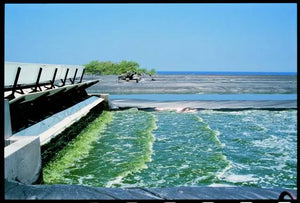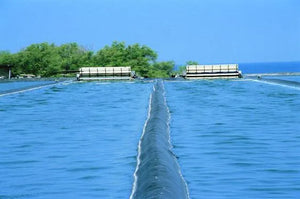Free Intensive Body Cream
Regular price £15.65
Unit price per
What is Hawaiian Spirulina?
What Are The Health Benefits
Hawaiian Pacifica Spirulina contains around sixty percent complete, highly digestible protein and contains every essential amino acid. It also contains more beta-carotene than any other whole food. It is the best whole food source of gamma linolenic acid (GLA). It is rich in B vitamins, minerals, trace elements, chlorophyll, and enzymes.
Hawaiian Pacifica Spirulina supplies nutrients that are lacking in most of our diets with:
- 300% more calcium than whole milk
- 2300% more iron than spinach
- 3900% more beta carotene than carrots
- 375% more protein than tofu
Spirulina is nature's richest whole-food source of naturally occurring organic iron. It's 58 times richer in iron than raw spinach and 28 times richer than raw beef liver. Spirulina is nature's richest source of beta-carotene (pro-vitamin A), it's 25 times higher than raw carrots!
You’ve heard the recommendation that we should eat five servings of fresh fruit and vegetables a day. This can be hard to achieve in real life. That’s where powerful supplements come in and help us maintain optimal health and wellbeing.
Phytonutrients are natural chemicals found in plants. They differ from essential vitamins and minerals that we need to keep us alive. Phytonutrients function to boost health and body functioning. When it comes to phytonutrient levels, Hawaiian Pacifica Spirulina is 31 times more potent than blueberries, 60 times more potent than spinach and 700 times more potent than apples.
Hawaiian Pacifica Spirulina's concentrated nutrition makes it an ideal food supplement for people of all ages and lifestyles.
If your brand is Hawaiian Pacifica Spirulina then you're buying The World's Best Spirulina!
Hawaiian Pacifica is the only Spirulina in the World that adds pure, mineral rich, Deep Ocean Water from 2000 feet below the Pacific containing a unique array of 94 trace elements – this valuable feature alone makes Hawaiian Pacifica the most complete and beneficial Spirulina available
It contains around sixty percent complete, highly digestible protein and contains every essential amino acid. It also contains more beta-carotene than any other whole food; it is the best whole food source of gamma linolenic acid (GLA); it is rich in B vitamins, minerals, trace elements, chlorophyll, and enzymes; and it is abundant in other valuable nutrients about which scientists are learning more each year, such as carotenoids, sulfolipids, glycolipids, phycocyanin, superoxide dismutase, RNA, and DNA.
Hawaiian Pacifica Spirulina supplies nutrients that are lacking in most of our diets. It provides athletes with long-lasting energy and reduces recovery time; it nourishes people who have digestion, assimilation, and elimination problems; it satisfies the appetite as it provides essential nutrients to weight watchers; it enables children and others who don't like vegetables to eat their greens by taking a few tablets; and it helps busy people who don't have time for regular, balanced meals to nourish themselves.
People with various health problems swear by Hawaiian Pacifica Spirulina – it appears to promote overall health and well-being.
How Does It Work?
How to Take Spirulina
POWDER
SUGGESTED USAGE: one serve = 3g (1 level teaspoon), use 1 – 3 serves per day.
TABLETS (500mg)
SUGGESTED USAGE: one serve = 6 tablets, use 1 – 3 serves per day.
NEW TO SPIRULINA?
If you have just started taking Hawaiian Pacifica Spirulina and perhaps are not used to a lot of greens in your diet, try half serves for the first few days and build up gradually.
When taking TABLETS, always drink a large glass of fresh water and remember to keep your daily water intake at 1-2 litres.
Our recommendations for spirulina usage come from our 20 years of experience and the results of research. There are no hard and fast rules regarding spirulina usage, it's safe in small or large quantities, and each individual will have a different requirement and preference. Just use the information below as a guide and experiment!
Unlike synthetic vitamin supplements, spirulina is a whole food, and as such is not consumed in small one or two tablet serves.
We also recommend that if you are new to spirulina, and perhaps not used to a lot of greens in your diet, you try half serves for the first few days and perhaps have it after food rather than on an empty stomach. A good time to use spirulina is after breakfast, then again mid afternoon.
Most people report increased energy levels after their systems adjust. You may take your spirulina all at once or more than once a day. Some people like to take it an hour before eating to satisfy their appetite.
Those with difficulty sleeping may wish to take their spirulina in the morning, rather than the evening, since the high protein content tends to wake you up.
Cold-Pressed TABLETS for convenience
For convenience and a quick nutritional boost any time, our tablets can be carried in a purse, backpack or suitcase.
Keep some at home and some at work. Hawaiian Pacifica Spirulina can go everywhere with you. A serve is six tablets, but you may prefer to use a bit less. Spirulina is a dry food so don't forget to drink plenty of water.
Kids and pets like to suck the tablets like lollies for the smooth buttery taste, then wash the dark green (chlorophyll) down with a big glass of water or juice.
Pure POWDER for green smoothies
Hawaiian Pacifica Spirulina Powder is 100% pure and can be shaken into fruit juice in any closeable container such as a drink bottle, blended with fruit or stirred into yoghurt. It's delicious!
Typical Analysis & INGREDIENTS
POWDER
Ingredients: 100% Pure Hawaiian Spirulina (Arthrospira platensis)
TABLETS (500mg)
Ingredients: Hawaiian Spirulina 98.5% (Arthrospira platensis), Silica 1%, Chicory Inulin 0.4%, Vegetable Magnesium Stearate 0.1%.
| Average Quantity | Per 3g | Per 100g |
| Energy | 41.85Kj | 1395Kj |
| Calories | 10 | 333 |
| Fat – Total | <0.2g | 5g |
| - Saturated | 0.0g | 0.0g |
| - Carbohydrate | <1g | <33.3g |
| - Sugars | 0.0g | 0.0g |
| Protein | 2g | 67g |
| PHYTONUTRIENTS | ||
| Total Carotenoids | 19mg | 633mg |
| Beta-carotene | 8mg | 286mg |
| Phycocyanin | 270mg | 9g |
| Chlorophyll | 19mg | 633mg |
| Zeaxanthin | 3mg | 100mg |
| Superoxide Dismutase (SOD) | 2,000units | 66,600units |
| AMINO ACIDS (essential) | ||
| Isoleucine | 97.8mg | 3,260mg |
| Leucine | 146.7mg | 4,890mg |
| Lysine | 78.6mg | 2,620mg |
| Methionine | 39.9mg | 1,330mg |
| Phenylalanine | 78.3mg | 2,610mg |
| Threonine | 84.3mg | 2,810mg |
| Tryptophan | 25.5mg | 850mg |
| Valine | 112.2mg | 3,740mg |
| Histidine | 45mg | 1,500mg |
| AMINO ACIDS (non-essential) | ||
| Alanine | 139.8mg | 4,660mg |
| Arginine | 142.8mg | 4,760mg |
| Aspartic Acid | 218.4mg | 7,280mg |
| Cysteine | 16.8mg | 560mg |
| Glutamic Acid | 253.2mg | 8,440mg |
| Glycine | 95.7mg | 3,190mg |
| Proline | 74mg | 2,470mg |
| Serine | 79.5mg | 2,650mg |
| Tyrosine | 71.4mg | 2,380mg |
| VITAMINS | ||
| Vit A (100% as betacarotene) | 4,525iu | 150,800iu |
| Vit E (d-a-tocopherol) | 285mcg | 9.5mg |
| Vit B1 (thiamine) | 3mcg | 100mcg |
| Vit B2 (riboflavin) | 179mcg | 6mg |
| Vit B3 (niacin) | 465mcg | 15.5mg |
| Vit B6 (pyridoxine) | 21mcg | 700mcg |
| Vitamin B12 (Cobalomin)
Bioavailable / Human-active B12 |
7mcg
2.5mcg |
233mcg
83mcg |
| Vit K1 and K2 | 50mcg | 1.7mg |
| Biotin | 1mcg | 33mcg |
| Inositol | 1.7mcg | 57mcg |
| Pantothenic Acid | 5mcg | 166mcg |
| MINERALS | ||
| Calcium | 10mg | 333mg |
| Magnesium | 15mg | 500mg |
| Potassium | 43mg | 1.4g |
| Iron | 5mg | 166mg |
| Phosphorus | 33mg | 1.1g |
| Sodium | 30mg | 1g |
| Manganese | 200mcg | 6.7mg |
| Zinc | 90mcg | 3mg |
| Selenium | 5mcg | 166mcg |
| Molybdenum | 12mcg | 399mcg |
| Chromium | 65mcg | 2.1mg |
| Iodine | 15mcg | 500mcg |
| Copper | 0.05mcg | 1.6mcg |
| Boron | 22mcg | 733mcg |
| ESSENTIAL FATTY ACIDS (EFA's) | ||
| Omega 6 Family | ||
| Gamma Linolenic (GLA) | 32mg | 1.07g |
| Essential Linoleic | 33mg | 1.1g |
| Dihomogamma Linolenic | 1.59mg | 53mg |
| Monoenoic Family | ||
| Palmitoleic | 5.9mg | 197mg |
| Oleic | 510mcg | 17mg |
| Erucic | 72mcg | 2.4mg |
| Other Fatty Acids | ||
| Palmitic Acid | 61mg | 2g |
| Myristic Acid | 400mcg | 13mg |
| Stearic Acid | 2.5mg | 83mg |
| Arachidonic Acid | 200mcg | 6.7mg |
| Behenic Acid | 144mcg | 4.8mg |
| Lignoceric Acid | 72mcg | 2.4mg |
Hawaiian Pacifica Spirulina is also a rich source of enzymes, RNA, DNA, sulfolipids, glycogen and other potentially important nutrients.
Reviews
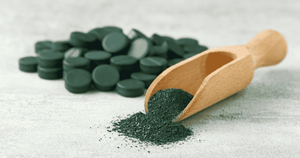
WHAT IS SPIRULINA?
Nature's richest whole-food source
A complete protein
It is nature's richest whole-food source of complete protein. Rich in GLA, it also contains important B complexes including bio-available B12 and other essential organic, whole-food minerals and trace elements.
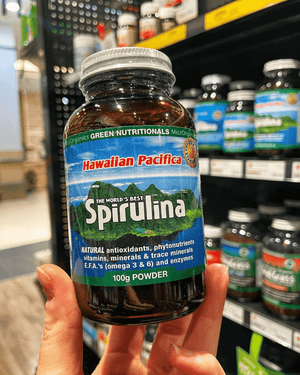
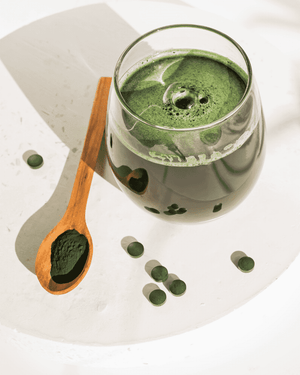
rich source of chlorophyll & iron
Spirulina is a rich whole-food source of chlorophyll - equal to that of alfalfa or wheat-grass. It contains a rich spectrum of available proteins and is the richest source of beta-carotene and mixed carotenoids in the world.
Spirulina is nature's richest whole-food source of naturally occurring organic iron. It's 58 times richer in iron than raw spinach and 28 times richer than raw beef liver.
RICH SOURCE OF ANITOXIDANTS
Spirulina is natures richest whole-food source of the entire anti-oxidant spectrum including: beta-carotene, selenium, super oxide dismutase (SOD), methionine, glutathionine, copper, manganese, zinc, B-1, B-2, B-3, B-5, and B-6. It is the only source of phycocyanin (the 'blue pigment' phytonutrient) which is a powerful immune stimulant.
Beta-carotene in Spirulina is completely non-toxic, even in mega doses.
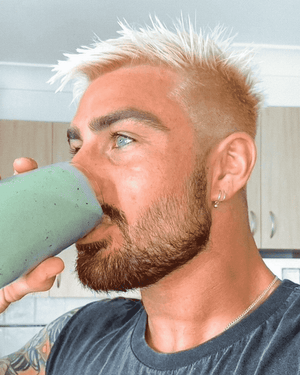
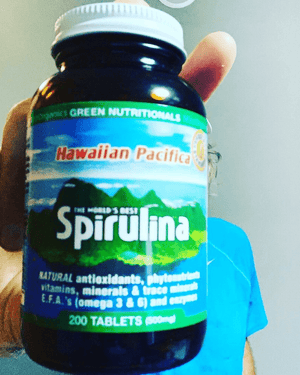
RICH IN FATTY ACIDS
Spirulina is nature's richest source of gamma linolenic acid (GLA). It's 3 times richer than evening primrose! The polyunsaturated oils in spirulina contain 21% GLA (GLA is the active ingredient in evening primrose oil - evening primrose oil contains up to 10% GLA.)
HAWAIIAN PACIFICA SPIRULINA
Hawaiian Spirulina is a select strain of arthrospira platensis developed over many years of continuous cultivation in Hawaii.
The Hawaiian Spirulina strain development and perfection started in 1984. The cultures grown by Cyanotech in Hawaii represent the oldest continuously cultivated and harvested spirulina in the world.
Hawaii's year-round grown conditions and integrated culture management system have made this possible. Hawaiian Spirulina has been extensively analysed by molecular biologists at the University of Hawaii who identified unique enzymes not previously found in other strains of spirulina platensis.
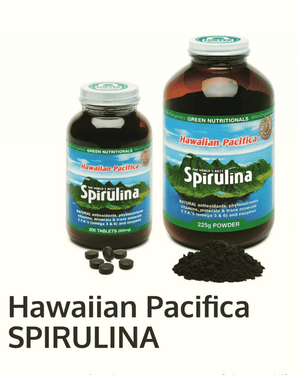
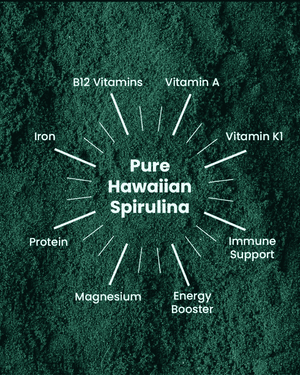
Natural vs Synthetic
Health supplements can be divided into two categories Natural or Synthetic.
Synthetic supplements make up over 90% of all supplements and are made in the laboratory, these include antioxidants, vitamins and amino acids. Sometimes they are an exact match of the compounds found in nature but often they are not, and importantly they do not come with the accompanying 'synergistic' components found in nature.
We are not evolved to use synthetic nutrients, and although there are instanced where the use of synthetics are required due to individual circumstances, we are best served by Natures Foods. Some fat soluble nutrients such as vitamin A for example, are stored by the body accumulatively and can be toxic – nature provides vitamin A in the safe form of safe beta carotene which is converted by the body into vitamin A as required.
The strongest argument against taking synthetic nutrients in isolation is the absence of accompanying compounds found in foods – millions of years of evolution have given us nutrient delivery systems in the form of whole food 'packages' that have served us well and can continue to do so.
Hawaiian Pacifica Spirulina and all the other GREEN NUTRITIONALS products contain only natural nutrients.
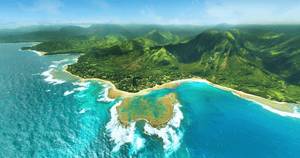
How is hawaiian pacifica sprirulina grown?
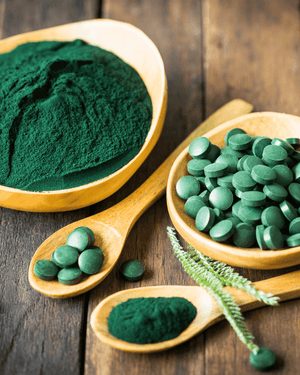
How and where is it grown
Hawaiian Pacifica Spirulina is grown by the renowned Cyanotech Corporation on the Big Island of Hawaii, USA without the use or any chemical fertilisers, pesticides, herbicides or genetically modified material.
Hawaiian Pacifica Spirulina is a specially bred strain of the edible micro-algae spirulina platensis. It is cultured in shallow, open ponds (approximately 20 cm deep) in Hawaii, adjacent to the Pacific Ocean. A combination of fresh Hawaiian aquifer (potable) water and supplemental mineral rich Deep Ocean water is used to fill the ponds.
